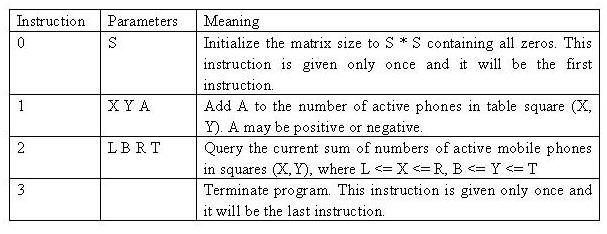[树状数组]POJ 1195 Mobile phones
来源:互联网 发布:ubuntu 共享 usb 网络 编辑:程序博客网 时间:2024/04/27 19:13
传送门:Mobile phones
Mobile phones
Time Limit: 5000MS Memory Limit: 65536KTotal Submissions: 13627 Accepted: 6316
Description
Suppose that the fourth generation mobile phone base stations in the Tampere area operate as follows. The area is divided into squares. The squares form an S * S matrix with the rows and columns numbered from 0 to S-1. Each square contains a base station. The number of active mobile phones inside a square can change because a phone is moved from a square to another or a phone is switched on or off. At times, each base station reports the change in the number of active phones to the main base station along with the row and the column of the matrix.
Write a program, which receives these reports and answers queries about the current total number of active mobile phones in any rectangle-shaped area.
Write a program, which receives these reports and answers queries about the current total number of active mobile phones in any rectangle-shaped area.
Input
The input is read from standard input as integers and the answers to the queries are written to standard output as integers. The input is encoded as follows. Each input comes on a separate line, and consists of one instruction integer and a number of parameter integers according to the following table.

The values will always be in range, so there is no need to check them. In particular, if A is negative, it can be assumed that it will not reduce the square value below zero. The indexing starts at 0, e.g. for a table of size 4 * 4, we have 0 <= X <= 3 and 0 <= Y <= 3.
Table size: 1 * 1 <= S * S <= 1024 * 1024
Cell value V at any time: 0 <= V <= 32767
Update amount: -32768 <= A <= 32767
No of instructions in input: 3 <= U <= 60002
Maximum number of phones in the whole table: M= 2^30

The values will always be in range, so there is no need to check them. In particular, if A is negative, it can be assumed that it will not reduce the square value below zero. The indexing starts at 0, e.g. for a table of size 4 * 4, we have 0 <= X <= 3 and 0 <= Y <= 3.
Table size: 1 * 1 <= S * S <= 1024 * 1024
Cell value V at any time: 0 <= V <= 32767
Update amount: -32768 <= A <= 32767
No of instructions in input: 3 <= U <= 60002
Maximum number of phones in the whole table: M= 2^30
Output
Your program should not answer anything to lines with an instruction other than 2. If the instruction is 2, then your program is expected to answer the query by writing the answer as a single line containing a single integer to standard output.
Sample Input
0 41 1 2 32 0 0 2 2 1 1 1 21 1 2 -12 1 1 2 3 3
Sample Output
34
Source
IOI 2001
解题报告:
题意:一个手机网络,命令0 S初始化一个S*S的地点,每个方格中包含0个电话,命令1 X Y A,在(X,Y)中增加A个电话,命令2 L B R T,查询L <= X <= R,B <= Y <= T范围的电话数。
输入:命令。
输出:对于每次查询给出结果。
思路:非常典型的二维树状数组。
代码如下:
#include <iostream>#include <cstdio>#include <cstring>using namespace std;int c[1100][1100];int n;int lowbit(int x){ return x&(-x);}void update(int x,int y,int val){ for(int i = x; i <= n; i += lowbit(i)) for (int j = y; j <= n; j += lowbit(j)) c[i][j] += val;}int getSum(int x,int y){ int sum=0; for(int i=x;i>0;i-=lowbit(i)) for(int j=y;j>0;j-=lowbit(j)) sum+=c[i][j]; return sum;}int main(){ int t,s,x,y,val; int x1,y1,x2,y2; scanf("%d%d",&t,&n); memset(c,0,sizeof(c)); while(scanf("%d",&s)&&s<3){ if(s==1){ scanf("%d%d%d",&x,&y,&val); update(x+1,y+1,val); } else if(s==2){ scanf("%d%d%d%d",&x1,&y1,&x2,&y2); int ans=getSum(x2+1,y2+1)-getSum(x2+1,y1)-getSum(x1,y2+1)+getSum(x1,y1); printf("%d\n",ans); } } return 0;} 0 0
- POJ 1195 Mobile phones 二维树状数组
- POJ 1195 Mobile phones【二维树状数组】
- POJ 1195 Mobile phones 二维树状数组
- poj 1195 Mobile phones 二维树状数组
- poj 1195 Mobile phones(树状数组)
- POJ 1195 Mobile phones 二维树状数组
- poj 1195 Mobile phones +二维树状数组
- POJ 1195 Mobile phones 二维树状数组
- Mobile Phones poj 1195--二维树状数组
- POJ 1195 Mobile phones【二维树状数组】
- POJ 1195 Mobile phones(二维树状数组)
- poj 1195 - Mobile phones(树状数组)
- POJ 1195 Mobile phones(二维树状数组)
- poj - 1195 - Mobile phones(树状数组)
- [树状数组]POJ 1195 Mobile phones
- POJ 1195 Mobile phones(二维树状数组)
- poj 1195 mobile phones 二维树状数组
- POJ 1195 Mobile phones 二维树状数组
- CentOS的u盘安装有u盘才启动,没有u盘无法启动。
- HDU2068 RPG的错排
- 时间设置和日期设置
- eCos系统的VSR支持(VSR Support)
- 《学习OpenCV》练习6-2
- [树状数组]POJ 1195 Mobile phones
- 对于"第一次创业者"应该给什么样的建议
- HDU2079 选课时间
- POJ 1852 Ants
- 前端工程师必备-网址篇(持续完善中)
- 1.Android学习笔记-工程目录
- 我的FileZilla使用总结
- 配置、监控闪回恢复区
- table总结insertRow、deleteRow 学习


